7 Anti-Inflammatory Dinner Ideas (That Also Support Your Gut Health)
Nourishing dinners that lower inflammation and boost gut health? Yes, please.
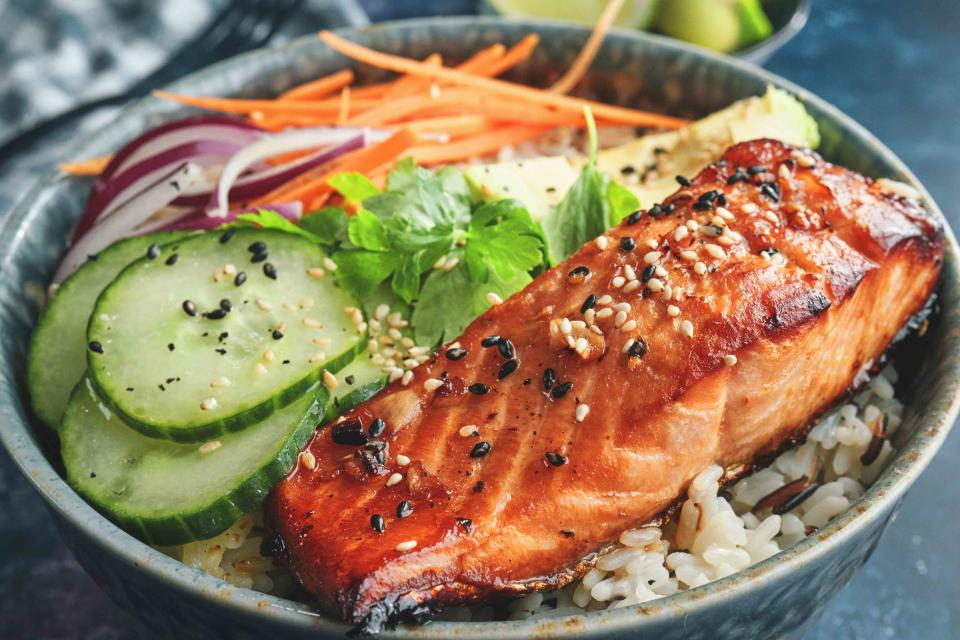
GMVozd/Getty Images
Nutrition plays a surprisingly influential role in how the body responds to inflammation, and certain foods are especially beneficial for supporting your system in fighting and managing harmful, low-grade inflammation. Here's how to make easy, nourishing, anti-inflammatory dinners, choose anti-inflammatory foods (and avoid pro-inflammatory ones!), and eat for a healthier gut, stronger immune system, and lower inflammation.
Acute Inflammation Is Natural and Beneficial
There are two main types of inflammation—acute and chronic. Acute inflammation occurs when your body experiences some type of harm, whether it’s a scrape on your knee or something more serious like an infection. Acute inflammation is temporary, and though it can sound scary, it’s actually doing your body good. “Acute inflammation helps us heal,” says Barbara Sobel, CNS, LDN, a licensed dietitian nutritionist in the San Francisco Bay Area. “Our immune system sends out inflammatory cells to help kill off any bacteria, infection, or viruses that have entered the body.”
The Trouble With Chronic Inflammation
But what happens when the body stays in a state of inflammation for a longer period of time? That’s when you start dealing with chronic inflammation. The signs of inflammation don’t always pop up right away, so it can be difficult to pinpoint, Sobel says. It’s a good reminder to see your healthcare provider for annual checkups so symptoms of inflammation don’t go missed. An additional route to manage inflammation is through diet, according to the Academy of Nutrition and Dietetics. We asked dietitians what anti-inflammatory dinners could look like, and they shared a wealth of tips and recipe ideas to add to your weekly rotation.
Foods That Can Cause Inflammation
Foods commonly found in the typical American diet are classic culprits of inflammation, says Samantha Cassetty, MS, RD, a registered dietitian in New York City. She cites examples like red meats, processed meats, refined grains, and added sugars as those that promote chronic inflammation. Ultra-processed foods high in sodium, trans fats, and saturated fats can also promote inflammation, per a 2023 review in Nutrients.
Part of the reason why these foods contribute to inflammation is because they’re low in fiber and nutrients from plant foods, which are nutrients that help quell chronic inflammation, Cassetty explains. It could also have something to do with how they affect the gut. According to the University of Chicago Medicine, processed foods can alter gut bacteria, and since most of the immune system lives in the gut, it can trigger inflammation.
Related: 5 Foods to Avoid for a Happy, Healthy Gut Microbiome
Foods That Help Fight Inflammation
Anti-inflammatory foods affect the gut differently, however. An anti-inflammatory diet is often one that also improves gut health because it’s full of fiber, antioxidants, and whole, plant-based foods, Cassetty adds. Higher fiber intake has been inversely associated with inflammation, studies show. Animal products—even the lean ones—are free of fiber, so eat plenty of plant foods like whole grains, legumes, fruits, vegetables, nuts, and seeds to get more of these anti-inflammatory nutrients. These foods have the added benefit of providing antioxidants, another anti-inflammatory nutrient Cassetty recommends loading up on. Antioxidants fight oxidative stress, a known cause of chronic inflammation.
Related: 9 Polyphenol-Rich Foods (and Drinks)—Plus Healthy Ways to Eat More of Them
Examples of Anti-Inflammatory Foods
When you put all of this together, what does an anti-inflammatory diet look like? According to the dietitians we spoke to, an eating pattern like the Mediterranean diet is a great example to follow. Long-term studies have linked the Mediterranean diet to reduced levels of low-grade (aka chronic) inflammation.
Start by avoiding ultra-processed foods high in added sugars, sodium, trans fats, and saturated fats. Examples include white bread, pastries, deli meats, fast food, French fries, and sugary drinks. You don’t have to avoid these foods forever—you can still enjoy them in moderation, though they shouldn’t make up the bulk of your diet.
Next, prioritize a variety of anti-inflammatory foods, which ideally will make up the majority of your meals. Wan Na Chun, RD, a registered dietitian in Indianapolis, recommends the following anti-inflammatory staples to create nourishing dinners:
Oily fish like salmon and tuna
Animal protein like poultry and eggs
Leafy vegetables like kale and spinach
Cruciferous vegetables like broccoli and cabbage
Fruits like blueberries and blackberries
Legumes like lentils and beans
Whole grains like brown rice and quinoa
Healthy fats like nuts, seeds, avocado, and olive oil
Fermented foods
You don’t have to include every single item at dinnertime—instead use this as a jumping off point for inspiration. Try to mix and match them for variety, flavor, and versatility! For example, a balanced plate could include some lean protein, whole grains, and vegetables or fruit, per the Harvard T.H. Chan School of Public Health. Top it off with some healthy fats or oils, and you’ve got an anti-inflammatory dinner.
Related: 7 Anti-Inflammatory Foods to Eat Every Day for Long-Term Health
Anti-Inflammatory Dinner Ideas
Mango Chicken Curry with Coconut Rice
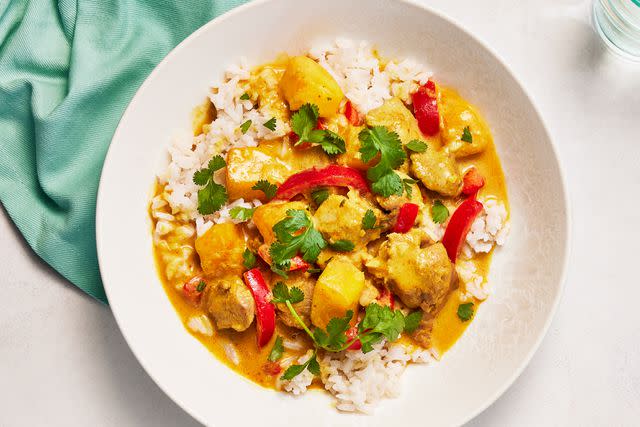
Jennifer Causey, Food Stylist: Julian Hensarling, Prop Stylist: Christina Daley
In its simplest form, a balanced dinner includes a grain or starch, protein, and vegetable. This curry chicken recipe accomplishes all three—and then some. “This recipe contains almost the full rainbow,” Sobel says, adding that an array of colorful veggies is a good sign of an anti-inflammatory meal.
She points to the red peppers, orange mango, yellow ginger, and green cilantro as vibrant sources of anti-inflammatory fruits and veggies that are also excellent sources of inflammation-fighting antioxidants. “The herbs, spices, coconut milk, and coconut oil are also anti-inflammatory foods that add flavor and creaminess to the dish,” she adds.
Plant-Based Walnut 'Meat' Tacos
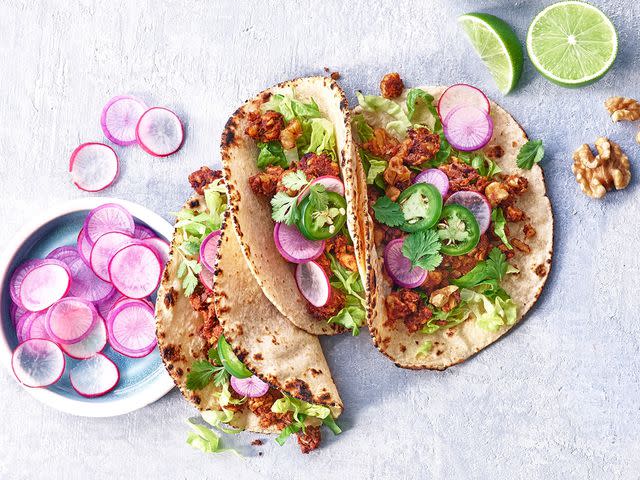
“This recipe is a great example of an anti-inflammatory dinner,” Cassetty says. “The taco mixture includes a blend of walnuts and black beans, which are an anti-inflammatory duo.” She points to a 2020 study that found that healthy older adults who included walnuts in their daily diet experienced improvements in several markers of inflammation. “Walnuts are the only nut with a significant source of the anti-inflammatory plant-based omega-3 fatty acid,” Cassetty adds.
What’s more, the black beans are a rich source of dietary fiber, protein, and anti-inflammatory phytochemicals. Finally, the whole thing is seasoned with anti-inflammatory spices and extra-virgin olive oil, which Cassetty calls an “anti-inflammatory superstar." “For maximum anti-inflammatory benefits, I’d serve this mixture over a salad or stuffed in whole-grain corn tortillas,” she says.
Related: 6 Nutrient-Packed Foods to Eat for Better Brain Health
One-Pan Salmon With Roasted Cabbage and Olive Vinaigrette
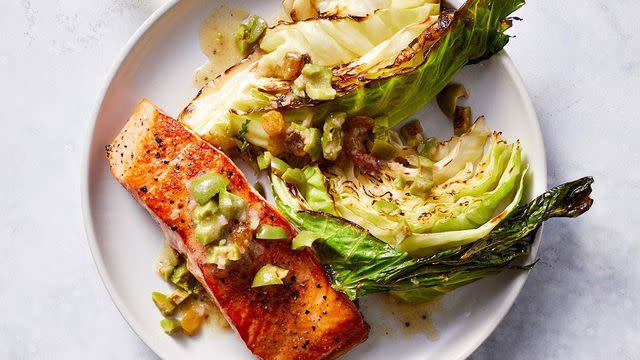
If you’re looking for an easy weeknight dinner, Chun recommends building a grain bowl. You’ll need a lean, anti-inflammatory protein source, and salmon is an excellent choice, she adds. This salmon recipe is quick, easy, and delicious, but most importantly, it’s full of anti-inflammatory ingredients. The omega-3 fatty acids found in salmon possess anti-inflammatory markers, research suggests. And since this recipe calls for cabbage, it also provides a serving of cruciferous vegetables.
Sheet-Pan Chicken With Potatoes and Green Beans
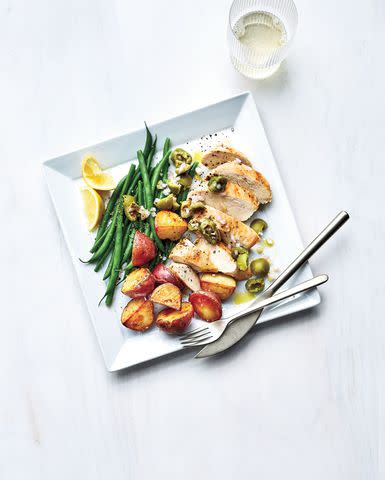
We love a good sheet pan dinner, and Sobel recommends this one for those looking to incorporate more anti-inflammatory meals. For starters, it’s simple to make, but it’s also got one of Sobel’s favorite features—color. Red potatoes, green beans, and olives add colorful antioxidants, which are stellar for reducing inflammation, she says. Plus, it includes the anti-inflammatory herb, oregano.
Chickpea Tuna Salad
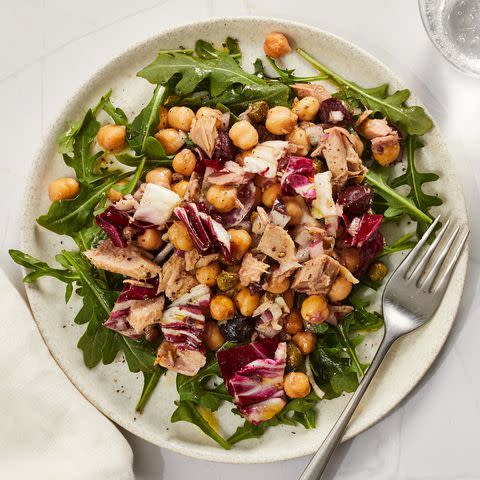
This recipe contains two protein sources—chickpeas and tuna—and both of which contain unique anti-inflammatory properties. Tuna salad recipes typically contain mayonnaise, but this one calls for olive oil, which Cassetty says is an important swap. “Research shows that olive oil is rich in anti-inflammatory compounds,” she explains. Plus, certain fats found in mayonnaise can be inflammatory, per the Arthritis Foundation.
While it’s full of protein, this recipe also packs plenty of veggies. The bed of arugula provides a source of leafy greens. Along with the chickpeas and radicchio, the trio of plant-based foods are high in fiber and other plant nutrients. “That means this meal also supports gut health, which plays a role in regulating inflammation,” Cassetty notes.
Tofu Fried Rice
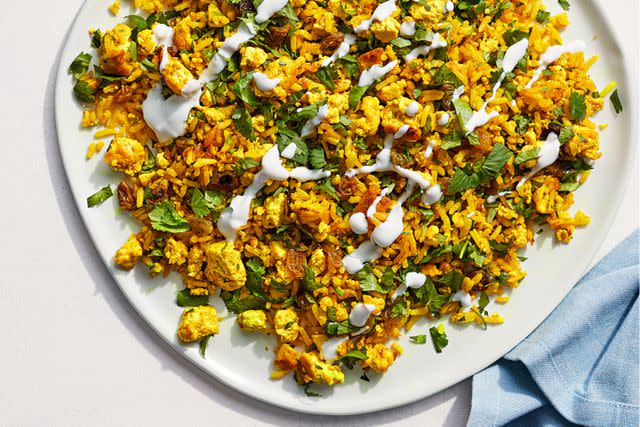
Fred Hardy
Whole, plant-based foods are among the best anti-inflammatory foods, according to the dietitians we spoke to, so here’s a recipe that’s full of them. It contains tofu, garlic, ginger, olive oil, turmeric, and more. We know that veggies, herbs, and spices can reduce inflammation, but what about tofu? The popular meat alternative is associated with a lowered risk of disease like heart disease and cancer, according to the Cleveland Clinic. It’s not only high in protein and micronutrients but also in isoflavones, a flavonoid with anti-inflammatory properties.
Seared Tuna with Tomato-Olive-Caper Salad
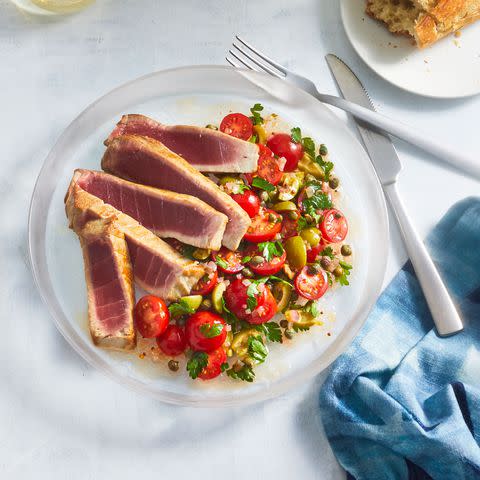
Fatty fish is often a go-to recommendation for an anti-inflammatory diet—the Mediterranean is full of them—and tuna doesn’t get enough hype. Salmon contains more omega-3 fatty acids than tuna, but tuna is still a nutritious protein that helps lower inflammation, our dietitians say. It’s also a good idea to get a variety of anti-inflammatory foods, so if you tend to reach for salmon, this tuna recipe could nudge you to try something new.
“This is a super-quick dinner with minimal prep and cook time, and it includes a variety of different plant foods,” Sobel says. And she’s right—it’s got tomatoes, olives, parsley, capers, and shallots. “It also contains mustard seeds, which are rich in antioxidants and help reduce inflammation.”
Related: 20 of Real Simple's Favorite Anti-Inflammatory Recipes That'll Make You Feel Better Than Ever
For more Real Simple news, make sure to sign up for our newsletter!
Read the original article on Real Simple.

